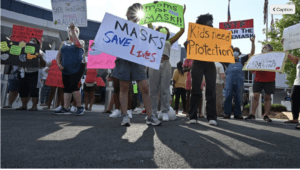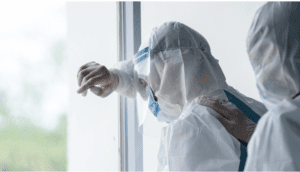As summer draws to a close, fall brings unique challenges. The surge of COVID-19 cases, instigated by the Delta variant, has heavily impacted the beginning of the new school year. In July, the CDC recommended that all students and staff wear masks in schools, regardless of vaccination status. The nature of this statement as a recommendation allowed school boards and local governments to make the ultimate decision – should masks in schools be required?
Many districts decided not to create thresholds for closures or markers to indicate when/if they might switch from an in-person environment to a virtual one in preparation for the school year. Instead, decisions regarding in-person versus remote instruction would be made on a case-by-case basis. Many school districts also decided not to enforce a mandatory mask in schools policy, despite CDC recommendations.
COVID-19 Surge
These decisions came during a surge in COVID-19 cases, with an unprecedented number involving children. During the week of August 28, the CDC reported approximately 200 COVID-19 cases per 100,000 children aged 12-17. Within that same time frame, only 118 cases of COVID-19 per 100,000 individuals aged 50-64 were reported. In fact, for the last two weeks of August, children aged 12-17 had a higher incidence rate of COVID-19 cases, per 100,000 individuals, than any other age group in the US. According to the American Academy of Pediatrics, mid-July to mid-August saw a fivefold increase in COVID-19 cases among children.
Pediatric hospitalizations due to COVID-19 have also risen. During the first week of August, the average daily child hospital admissions were around 220. From August 20-26, that number has increased to 330 COVID-positive children hospitalized per day. Moreover, data analyzed from cases dated March 2020-June 2021 alarms health authorities even further; almost half (46.4%) of all COVID-19 hospitalized pediatric patients do not have any known underlying conditions – these are normal, healthy children.
What’s happening in schools now?
In Arizona, the semester kicked off at the beginning of August. In Maricopa County, which includes Phoenix, many schools did not mandate masks, leaving it up to parents and students. Before school began, children made up 3% of all COVID-related hospitalizations in the county. That number doubled within the first month of school, and now pediatric hospitalizations constitute 6% of all COVID-related hospital admissions.
Furthermore, Maricopa County Health Department opened investigations into 166 separate outbreaks in schools. Following an analysis of these cases, Dr. Rebecca Sunenshine of the Maricopa Health Department told the County Board of Supervisors that schools without mask mandates are “twice as likely to have an outbreak” as schools that require masks. In addition, one in six COVID-19 cases in the county is a child under the age of 12. Despite all this, Governor Ducey’s ban on mask mandates stands to go into effect on September 29.
In Georgia, Atlanta school districts reported over 21,000 cases of COVID-19 among students and staff just two weeks into the school year. Cobb County schools, which recorded the highest number of cases at 2,797, do not require wearing masks. However, other counties, such as Fulton, which reported 1,914 cases, quickly reversed their optional mask-wearing policies, requiring face coverings for all students and teachers following the surge.

Delta Variant
Numerous counties, such as Macon, Glascock, Talbot, Long, Ware, and others, were forced to switch to remote learning for a period due to a large increase of cases. With so many students and staff needing to stay at home, keeping students in an in-person learning environment becomes a question of staffing and logistics, as well as safety. When addressing the surge of COVID cases among Georgia’s youth, Georgia Public Health Commissioner Kathleen Toomey has stated that schools are “where there is transmission going on.”
Even counties with mask mandates in schools, such as Los Angeles, California, have reported staggering numbers of COVID-19 cases among their children. The high incidence of the Delta Variant in the area is contributing to outbreaks not just in schools, but offices, private businesses, and transportation hubs. COVID-19 testing was required for students in the Los Angeles Unified School District (LAUSD) to return to in-person classes in August. Around 3,000 students tested positive, requiring another 3,500 students to isolate due to their status as close contacts.
Across LA County, the case rates, along with hospitalization and death, are much more prominent among unvaccinated individuals. LA County Public Health Director Barbara Ferrer reports that vaccinated individuals are “four to eight times less likely to be hospitalized, and five to seven times less likely to die from an infection.” Due to many children not being eligible for the COVID-19 vaccine, Director Ferrer insists they take “as many precautions as feasible to limit the risk of transmission.” The LAUSD requires facial coverings, testing in schools, and is now operating a vaccine clinic for any students that wish to be vaccinated, with parent/guardian approval, to protect students from illness while ensuring their education continues.
The Push for In-person Classes
Schools requiring masks or leaving them optional are reporting the same thing: an unprecedented increase in COVID-19 cases among America’s children. So if schools are a breeding ground for transmission, should there be discussion around remote learning?
Every grade level poses its challenges and benchmarks for academic development, and virtual learning can be difficult for children with specific learning styles. For example, it may be tough for hands-on learners to retain information through a screen. Similarly, learners may become easily distracted by seeing other students’ faces on monitors or even distracted by other stimuli in their space at home. Without observing students in the same room, teachers may have trouble identifying when students are struggling academically, losing focus, or not keeping up with the group’s pace.
Outside of academic and curricular standards, a school community allows children to socially develop, form bonds, and build confidence and independence apart from their family unit. Interacting with peers in the same age group helps students develop and understand relationships; it can be tough to connect with someone in the same way over a video screen. An in-person environment fosters socialization and engagement at a crucial time in a child’s development that remote learning struggles to provide.
The physical space that a school offers can also be a safe haven for students. Schools provide routine, direct access to adults and friends, which can, in turn, help children who face challenges at home. School meals can also provide vital nutrition for students who may not receive it elsewhere.
Implications
In-person learning environments play a vital role in the academic and social development for children and their well-being. To continue to provide this necessary experience, Dr. Tina Tan, chair of the American Academy of Pediatrics Section on Infectious Diseases, says, “you have to do everything to prevent the spread of COVID in school.” As a result, parents, school boards, state and local governments are now making decisions that affect the health of America’s youth, with significant implications to public policy.

Vaccinations are the easiest solution to protecting against symptomatic infection, hospitalizations, and death caused by COVID-19; however, none of the COVID-19 vaccines have full FDA approval for administration to children. Pfizer’s recent FDA approval is granted for individuals 16 years old and older only. It is unlikely that schools will mandate vaccines unless they receive full FDA approval; therefore, masks and other mitigation strategies are the best possible deterrent to COVID-19 outbreaks and the best way to ensure a sustainable in-person learning environment.
Bans on Mask Mandates
Within the summer months, many states have enacted bans against mask mandates. Iowa, Oklahoma, South Carolina, Tennessee, and Utah have enacted certain policies that either ban the mandatory wearing of masks or curb policies intended to do so. For example, Iowa state law prohibits schools from requiring masks outright; in contrast, Tennessee schools can make mask mandates, but Governor Lee’s recent Executive Order grants parents and guardians the ability to opt their children out of such requirements. In late August, the Department of Education opened a civil rights investigation into such policies, saying it may infringe on the rights of students with disabilities and medical conditions to safely receive the “free public education” that they are guaranteed by law. Students with immunocompromising conditions may be at adverse risk of attending public schools that do not require mask-wearing.
Several other states have attempted to enact similar bans on masks. Florida, Texas, Arizona, and Arkansas have all issued bans; their courts have either overturned the legislation or not yet gone into effect. However, if the bans go into effect, the Department of Education will take action against these states.
Bottom Line
While masks may be cumbersome, and many parents may not believe in their effectiveness in curbing COVID-19, data indicates that facial coverings are integral to maintaining the safety of children and staff in schools. When used in concert with social distancing, increased handwashing, and health screenings, facial coverings have a legislation and judicial proceedings that emerge from this pandemic may shape the role of schools and states in forming public health policy. Epidemiologists will continue to investigate why the Delta variant appears to be so much deadlier to children than the original SARS-CoV-2 strain, and lawmakers will continue to form decisions based on relevant data and the interests of their constituents.
During this highly fluid time, something as simple as wearing a mask may not only secure the necessary and developmental experience of going to school but may also save the lives of children and community members in the face of a rapidly evolving public health threat.
